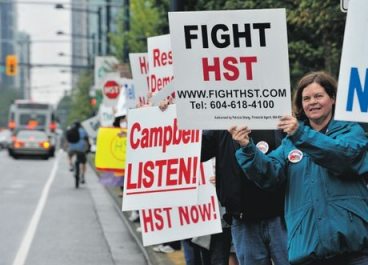By Karen Aney (The Cascade) – Email
Date Posted: September 15, 2011
Print Edition: September 14, 2011
 Now that the result of the referendum has been made official, a reported 54.7 per cent of the British Columbians who cast a ballot are celebrating the loss of the Harmonized Sales Tax (HST). Though the change back to PST and GST could take up to 18 months, democracy has spoken, and the Liberals have pledged to respect the decision of BC voters.
Now that the result of the referendum has been made official, a reported 54.7 per cent of the British Columbians who cast a ballot are celebrating the loss of the Harmonized Sales Tax (HST). Though the change back to PST and GST could take up to 18 months, democracy has spoken, and the Liberals have pledged to respect the decision of BC voters.
There were reported advantages and disadvantages to both sides. Under the HST, small-business owners were beginning to see promising benefits. One such owner in Abbotsford, who wished to remain anonymous, claimed that he/she has already seen profits since the HST was introduced. When asked if those profits would be reflected in reduced costs to his/her consumer, the respondent stated: “No. With people being so broke lately, I couldn’t raise prices at all. The market was too competitive. The profits I’m seeing are acting as kind of a back-end raise for me.” Studies conducted on the HST’s effect on other countries have shown a marked decline in consumer costs, but no such effects have occurred yet in British Columbia.
The referendum itself was not without controversy. Claims that this was a poll of “the ignorant and the non-ignorant”, as tweeted by one HST supporter, were echoed far and wide. Accusations that the method of voting was far from effective – as the mail-in ballots were sent in conjunction with a rotating strike at Canada Post – seemed to be reflected in mass expressions of frustration from citizens unable to vote.
One caveat of the strike-down of this tax is that the province of BC is now required to pay back the $1.6 billion loan it received from the federal government with the purpose of instigating the HST. Despite the argument that many British Columbians never asked for this loan, Federal Finance Minister Jim Flaherty stated that there will be no leniency: “I’ve discussed the issue more than once with the minister of finance of British Columbia [Kevin Falcon] and I’m satisfied B.C. will honour the terms of the agreement that we have with the province.”
Including this sum, Falcon has estimated that the cost of returning to the PST/GST system will come to a total of $2.2 billion in the next year alone, with an estimated jump to $2.8 billion by the time the changes have been permanently implemented. To put that in perspective, examine it alongside another political issue in BC at the moment: the impending teacher’s strike. One of their demands is for smaller class sizes; Education Minister George Abbott has stated: “… to reduce every class in BC by one student it would cost us $150 million”. Translation: $2.2 billion could buy some pretty small class sizes.Less people voted in the HST referendum than in the most recent provincial election in 2009. According to Statistics Canada, out of an estimated 3,238,737 eligible voters, 1,610,125 voted for the HST referendum. 1,640,542 voted for the provincial election. The question, then, is regarding what happened to the extra 30,000 voters, as the passionate demonstrations seem to suggest a lack of apathy.
Reducing the scope of examination to one electoral district can prove illuminating. In Surrey-Whalley, a district known for low response rates and low income, 15,887 people out of 32,918 people voted for the recent referendum, giving them a response percentage of approximately 48 per cent. In the 2011 Census, conducted this past summer, response rates in that same area were at approximately 32 per cent percent before census employees were deployed to obtain more forms. Like the 30,000 voter gap, this 16 per cent response drop could possibly be attributed to disdain for the census – but the higher response rate could also reflect the importance British Columbians placed on the referendum.
UFV student Maria Gabor-Martinez was one of the frustrated voters who couldn’t voice her opinion. “I didn’t because I never got my [package], so I couldn’t send it in,” she said. The other members of her household all received their voting packages and were able to vote. Another student, Will Olthuis, offered an alternate explanation for the lack of citizens who voted: “I was planning on it, but I didn’t end up doing it. I filled out the card, I just couldn’t decide which way to vote. I looked at both sides, I read the articles. With the short term and the long term effects, I wasn’t really sure. Who really is?”
One burning question: who’s going to be paying back the $2.2 billion? In a public statement from May 25th, Finance Minister Kevin Falcon declared that, if upheld, these funds would be recovered by a temporary increase to corporate taxes from 10 per cent to 12 per cent. Will a similar method be employed to help recover some of the deficit? Olthuis didn’t think so. “I know who it will come from,” he declared. “The taxpayers.”

